| "The Churches of Orange County, NC" by L. J. Phipps From the book "Orange County" edited by Hugh Lefler & Paul Wager |
In searching out the origins of the churches of Orange County, one will see that the early settlers, zealous
for their freedom of body, mind and spirit and finding the old regimes of their homelands encroaching
upon their religious principles, came not only from Europe, but from other American colonies as well, in
their search for new lands where they might work out their own salvation with fear and trembling in the
sight of God, but without fear of any man.
The laws of 1752, which created Orange County, also, established the Parish of St. Matthews and named
as vestrymen the following: Alexander Maben, James Watson, Mark Morgan, John Patterson, Andrew
Mitchell, Thomas Loveletter, Lawrence Bankston, James Ellison, William Bolling, John Gray, John Pitman
and Joseph Tate.
In 1754, 1758, 1760, 1761 and 1762 passage of a Vestry Act was attempted by Governor Arthur Dobbs,
but disallowed by King George II. As a result, Anglican clergy were left without support and the number
of clergymen in North Carolina began to decrease. Under the encouragement of Governors William Tryon
and Josiah Martin and supported by the Vestry Act of 1764, the number of clergymen increased.
No dates have been established, but it is known that in addition to St. Matthews Church in Hillsboro, two
other chapels of the Church of England were organized in Orange County prior to the Revolution, St.
Mary's and New Hope. The Rev. George Micklejohn, rector of the parish, probably preached at all
three places until the outbreak of the Revolution, when he, like most of the other ministers of the
Church of England, was compelled to resign his position because he remained loyal to the crown.
~ ~ ~ ~ ~ ~ ~ ~ ~ ~
A listing of some of the churches of Orange County from the book:
for their freedom of body, mind and spirit and finding the old regimes of their homelands encroaching
upon their religious principles, came not only from Europe, but from other American colonies as well, in
their search for new lands where they might work out their own salvation with fear and trembling in the
sight of God, but without fear of any man.
The laws of 1752, which created Orange County, also, established the Parish of St. Matthews and named
as vestrymen the following: Alexander Maben, James Watson, Mark Morgan, John Patterson, Andrew
Mitchell, Thomas Loveletter, Lawrence Bankston, James Ellison, William Bolling, John Gray, John Pitman
and Joseph Tate.
In 1754, 1758, 1760, 1761 and 1762 passage of a Vestry Act was attempted by Governor Arthur Dobbs,
but disallowed by King George II. As a result, Anglican clergy were left without support and the number
of clergymen in North Carolina began to decrease. Under the encouragement of Governors William Tryon
and Josiah Martin and supported by the Vestry Act of 1764, the number of clergymen increased.
No dates have been established, but it is known that in addition to St. Matthews Church in Hillsboro, two
other chapels of the Church of England were organized in Orange County prior to the Revolution, St.
Mary's and New Hope. The Rev. George Micklejohn, rector of the parish, probably preached at all
three places until the outbreak of the Revolution, when he, like most of the other ministers of the
Church of England, was compelled to resign his position because he remained loyal to the crown.
~ ~ ~ ~ ~ ~ ~ ~ ~ ~
A listing of some of the churches of Orange County from the book:
Quakers
The Quakers, who in 1752, found themselves within the limits of the newly created Orange County, began
coming into that area in 1748 on a wave of migrations which penetrated the whole of the Carolina Piedmont,
a product of a great chain of migrations of their own which broke out from Pennsylvania two decades earlier.
In the Quaker settlements in the interior of the Carolinas, the Cane Creek Monthly Meeting occupied the
pivotal position. Every Meeting in Western North Carolina traces is constitutional ancestry back to Cane
Creek.
The Society of Friends has always maintained a strong testimony against resort to war. The Cane Creek
Meeting was put to a severe test during the period of the Regulator movement and the succeeding period of
the Revolution. The geographic limits of the Orange County Quaker Meetings were torn by the activities in
each of these great movements. By the end of the Revolution, Cane Creek Meeting had disowned between 40
and 50 of the men of its membership for joining the Regulators or for participation in the Revolution.
The establishment of Guilford, Chatham and Alamance Counties removed most of the Quakers from Orange
County, leaving only the Eno Meeting, which came to an end approximately 100 years after the founding of
Orange County. A large cemetery surrounded by a rock wall is all that now marks the spot of the Meeting.
The location is just off the Hillsboro-Schley road and about one-quarter of a mile east of Mars Hill Baptist
Church. During the reconstruction period the Friends from Philadelphia operated a school for ex-slaves in
Chapel Hill on West Franklin Street for many years, eventually transferring the property to the local school
board. They, also, transferred a lot in Hillsboro to Dickerson's African Methodist Episcopal Church.
The Quakers, who in 1752, found themselves within the limits of the newly created Orange County, began
coming into that area in 1748 on a wave of migrations which penetrated the whole of the Carolina Piedmont,
a product of a great chain of migrations of their own which broke out from Pennsylvania two decades earlier.
In the Quaker settlements in the interior of the Carolinas, the Cane Creek Monthly Meeting occupied the
pivotal position. Every Meeting in Western North Carolina traces is constitutional ancestry back to Cane
Creek.
The Society of Friends has always maintained a strong testimony against resort to war. The Cane Creek
Meeting was put to a severe test during the period of the Regulator movement and the succeeding period of
the Revolution. The geographic limits of the Orange County Quaker Meetings were torn by the activities in
each of these great movements. By the end of the Revolution, Cane Creek Meeting had disowned between 40
and 50 of the men of its membership for joining the Regulators or for participation in the Revolution.
The establishment of Guilford, Chatham and Alamance Counties removed most of the Quakers from Orange
County, leaving only the Eno Meeting, which came to an end approximately 100 years after the founding of
Orange County. A large cemetery surrounded by a rock wall is all that now marks the spot of the Meeting.
The location is just off the Hillsboro-Schley road and about one-quarter of a mile east of Mars Hill Baptist
Church. During the reconstruction period the Friends from Philadelphia operated a school for ex-slaves in
Chapel Hill on West Franklin Street for many years, eventually transferring the property to the local school
board. They, also, transferred a lot in Hillsboro to Dickerson's African Methodist Episcopal Church.
Protestant Episcopal
The Revolution almost destroyed the colonial Church of England. Few thought of any future for this church,
which suffered more than any other in the colonies. It was slow in becoming re-established as the
Protestant Episcopal Church. With the outbreak of the Civil War, disruption again threatened the church, it
survived this threat.
Churches:
St. Mary's Chapel was admitted to the Episcopal Convention in 1819 and the building was consecrated in
1859; services were discontinued in about 1930.
St. Matthews of Hillsboro dates its founding in Orange County to the original Church of England in 1752. It
was inactive during the Revolution, but was reorganized in 1824, when the present building was erected.
The first rector of the reorganized church was the Rev. William Mercer Green, who was afterwards Bishop
of Mississippi.
Chapel of the Cross of Chapel Hill was organized in 1842 and the first pastor was the Rev. William Mercer
Green; first chapel erected in 1848; present building in 1925.
The Revolution almost destroyed the colonial Church of England. Few thought of any future for this church,
which suffered more than any other in the colonies. It was slow in becoming re-established as the
Protestant Episcopal Church. With the outbreak of the Civil War, disruption again threatened the church, it
survived this threat.
Churches:
St. Mary's Chapel was admitted to the Episcopal Convention in 1819 and the building was consecrated in
1859; services were discontinued in about 1930.
St. Matthews of Hillsboro dates its founding in Orange County to the original Church of England in 1752. It
was inactive during the Revolution, but was reorganized in 1824, when the present building was erected.
The first rector of the reorganized church was the Rev. William Mercer Green, who was afterwards Bishop
of Mississippi.
Chapel of the Cross of Chapel Hill was organized in 1842 and the first pastor was the Rev. William Mercer
Green; first chapel erected in 1848; present building in 1925.
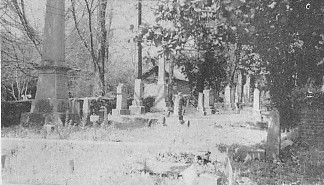
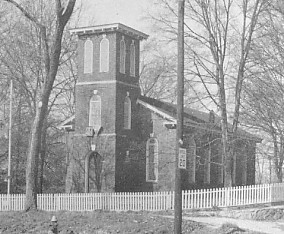
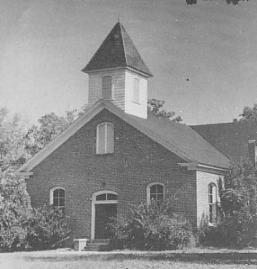
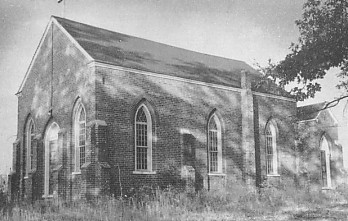
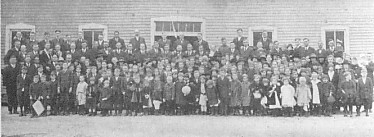
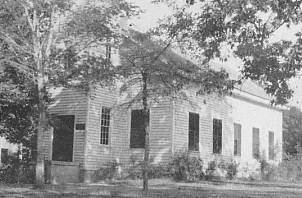
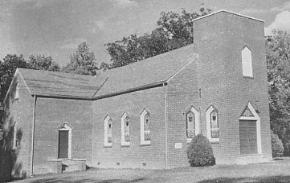
Presbyterian
The pioneers who settled Piedmont North Carolina about the middle of the 18th century were largely
Scotch and Scotch-Irish and were of the Presbyterian faith. Presbyterianism had its origin in the struggle
to prevent the state from exercising control of church government. The Presbyterian form of government
had long been characteristic of the established church of Scotland and, with some doctrinal variations, the
pioneers adapted this religion to the needs of the frontier people. Presbyterians migrated by the thousands
to Pennsylvania, where the principles of civil and religious liberty were fully entertained; but, partly from
the difficulty of obtaining land, and partly for other reasons, they found it expedient to move further south.
In Virginia, land could be obtained, but the government there was in constant hostility with religious
freedom, and the greater part of the people came to North Carolina and settled on the lands of the Earl of
Granville. Combining the intelligence, orthodoxy and piety of the Scotch with the ardor and love of liberty
peculiar to the Irish, they were the most efficient supporters of the American cause during the Revolution
and have done much for the support of learning, morality and religion.
The first Presbyterian Churches established were Grier's Presbyterian Church at High Towers, now in
Caswell County, in 1753, followed by Hawfield's in what is now eastern Alamance in 1755 and Eno, now
located at Cedar Grove, in 1755 and New Hope in 1756. The pastors of these churches constituted, in
1770, the first Presbytery for North Carolina, known as the Orange Presbytery. The leaders of these
churches were distinguished for dissent in politics, as well as in religion and David Caldwell, particularly,
was a most sympathetic adviser of the Regulators and voiced the sentiments of pure democracy in the
Halifax convention of 1776.
Churches:
Eno Presbyterian Church was organized in 1755; leader was Hugh McAden; first pastor was Henry Patillo.
It was originally located on Eno River, about 2 miles southeast of Cedar Grove, but after its building was
destroyed by the fire of 1890, the church moved to Cedar Grove.
New Hope Presbyterian Church was organized in 1756; leaders were Gilbert Strayhorn and John Craig;
first pastor was Henry Patillo; first building erected in 1756 and the fourth building erected in 1863.
Little River Presbyterian Church was organized in 1761; leader was Hugh McAden; first pastor was Henry
Patillo.
Hillsboro Presbyterian Church was organized in 1816; leaders were Rev. John Witherspoon, Susan D.
Witherspoon, Frank Nash, Mary G. Nash, James Phillips, Mary Phillips, Anne A. Webb, Mary Burk, Henry
Thompson, Sr. and John Allison; first pastor was Rev. John Witherspoon; the building was erected in 1816.
Bethlehem Presbyterian Church was organized in 1822; leaders were Rev. Elisha Mitchell, Rev. Elijah
Graves and Col. Samuel Child; first pastor was Rev. John Witherspoon; first building erected in 1823.
Fairfield Presbyterian Church was organized in 1834; first pastor was Samuel Paisley.
The Presbyterian Church of Chapel Hill was organized in 1845; leaders were James Phillips, Rev. Elisha
Mitchell, Charles Phillips and David Swain; first pastor was Rev. John B. Shearer; building was erected in
1840 and remodeled in 1919.
Efland Presbyterian Church was organized in 1908; leaders were D. C. McAdams, M. L. Efland, D. E.
Forrest, Rev. S. M. Rankin, Rev. M. C. Arrowood and John Efland, Sr.; first pastor was Rev. S. M. Wilhelm;
building erected in 1910.
The pioneers who settled Piedmont North Carolina about the middle of the 18th century were largely
Scotch and Scotch-Irish and were of the Presbyterian faith. Presbyterianism had its origin in the struggle
to prevent the state from exercising control of church government. The Presbyterian form of government
had long been characteristic of the established church of Scotland and, with some doctrinal variations, the
pioneers adapted this religion to the needs of the frontier people. Presbyterians migrated by the thousands
to Pennsylvania, where the principles of civil and religious liberty were fully entertained; but, partly from
the difficulty of obtaining land, and partly for other reasons, they found it expedient to move further south.
In Virginia, land could be obtained, but the government there was in constant hostility with religious
freedom, and the greater part of the people came to North Carolina and settled on the lands of the Earl of
Granville. Combining the intelligence, orthodoxy and piety of the Scotch with the ardor and love of liberty
peculiar to the Irish, they were the most efficient supporters of the American cause during the Revolution
and have done much for the support of learning, morality and religion.
The first Presbyterian Churches established were Grier's Presbyterian Church at High Towers, now in
Caswell County, in 1753, followed by Hawfield's in what is now eastern Alamance in 1755 and Eno, now
located at Cedar Grove, in 1755 and New Hope in 1756. The pastors of these churches constituted, in
1770, the first Presbytery for North Carolina, known as the Orange Presbytery. The leaders of these
churches were distinguished for dissent in politics, as well as in religion and David Caldwell, particularly,
was a most sympathetic adviser of the Regulators and voiced the sentiments of pure democracy in the
Halifax convention of 1776.
Churches:
Eno Presbyterian Church was organized in 1755; leader was Hugh McAden; first pastor was Henry Patillo.
It was originally located on Eno River, about 2 miles southeast of Cedar Grove, but after its building was
destroyed by the fire of 1890, the church moved to Cedar Grove.
New Hope Presbyterian Church was organized in 1756; leaders were Gilbert Strayhorn and John Craig;
first pastor was Henry Patillo; first building erected in 1756 and the fourth building erected in 1863.
Little River Presbyterian Church was organized in 1761; leader was Hugh McAden; first pastor was Henry
Patillo.
Hillsboro Presbyterian Church was organized in 1816; leaders were Rev. John Witherspoon, Susan D.
Witherspoon, Frank Nash, Mary G. Nash, James Phillips, Mary Phillips, Anne A. Webb, Mary Burk, Henry
Thompson, Sr. and John Allison; first pastor was Rev. John Witherspoon; the building was erected in 1816.
Bethlehem Presbyterian Church was organized in 1822; leaders were Rev. Elisha Mitchell, Rev. Elijah
Graves and Col. Samuel Child; first pastor was Rev. John Witherspoon; first building erected in 1823.
Fairfield Presbyterian Church was organized in 1834; first pastor was Samuel Paisley.
The Presbyterian Church of Chapel Hill was organized in 1845; leaders were James Phillips, Rev. Elisha
Mitchell, Charles Phillips and David Swain; first pastor was Rev. John B. Shearer; building was erected in
1840 and remodeled in 1919.
Efland Presbyterian Church was organized in 1908; leaders were D. C. McAdams, M. L. Efland, D. E.
Forrest, Rev. S. M. Rankin, Rev. M. C. Arrowood and John Efland, Sr.; first pastor was Rev. S. M. Wilhelm;
building erected in 1910.
Methodist
Methodism was formed in 1729, chiefly by John and Charles Wesley, sons of a clergyman of the Church of
England. Methodism was from the outset frankly evangelical and the Methodists were not restrained by
doctrinal obstacles from carrying the message of the gospel to rich or poor, wherever and whenever they
could be found. George Whitefield is regarded as one of the patriarchs of the Methodist Church. He was
"a flame of fire" from Georgia to Main, visiting North Carolina in 1739 and several times thereafter; his
great work was breaking down the barriers to the direct relationship of man and God. This was
essentially a democratic process and those early preachers were more or less unconsciously helping the
political revolution at the time they were preparing the ground for the religious awakening in the colonies.
Despite John Wesley's attempts to keep the movement an evangelical party within the Church of England
but, ultimately, it became a separate organizaton. Before long, Methodism had come to the colonies. The
Methodist ministers prior to the Revolution were nearly all from England and were so roughly treated
during the Revolution that nearly all of them had fled to either Canada or England by 1779.
After the Revolution, Francis Asbury worked almost single-handedly and a miracle seemed to happen.
Methodism not only swept through the cities, it developed an amazing strength in small towns and in the
rural areas. Everywhere there were circuit riders, ministers on horseback, riding the expanding frontier.
The circuit riders in North Carolina brought the influence of this denomination to nearly every section of
the state.
Churches:
New Sharon Methodist Church was organized in 1768.
Hillsboro Methodist Church was organized about 1807; the building was erected in 1867.
Lebanon Methodist Church was organized about 1830.
Cedar Grove Methodist Church was organized about 1830.
Orange Methodist Church was organized in Davis School House, near the Wash Fowler home about 1830;
leaders were Rev. Alexander Gattis, Jones Watson, William Robson, Isaac J. Collier, Elijah Hatch, James
Gattis, Daniel Hogan, Wesley Snipes, Jacob Potts and William gattis; the first pastor was Rev. Alexander
Gattis; the first building was erected about 1838.
Pleasant Green Methodist Church was organized about 1832; leaders were William Harris, William Piper,
Samuel Piper, Jacob Pealor, Abel G. Jackson, Francis F. Workman, Thomas W. Holden.
Clover Garden Methodist Church was organized before 1836; building erected in 1836.
Union Grove Methodist Church was organized in 1846; leaders were Thomas Long, Lemuel Carroll,
Thomas C. Hayes, Calvin Bishop and Daniel thompson; first pastor was, possibly, Alson Gray.
Walnut Grove Methodist Church was organized about 1850.
Orange Chapel Methodist Church was organized in 1850; leader was Alson Gray; first pastor was Alson
Gray (circuit rider); first building was erected in 1850.
University Methodist Church of Chapel Hill was organized in 1853; leaders were Charles F. Deems and
Rev. J. Milton Frost; first pastor was Rev. J. Milton Frost.
New Bethel Methodist Church was organized in 1859; leaders were John R. McMannan, Jonathan Nichols,
William H. Pass, William Carrington, William Harris, Robert N. Hall and Jackson Latta.
Chestnut Ridge Methodist Church was organized about 1890.
Efland Methodist Church was organized in 1905; leaders were Mrs. M. P. Efland, Mr and Mrs. O. E. Bivins
and Mr. and Mrs. C. A. Bivins; first pastor was Rev. W. d. Fogleman; building was erected in 1905.
Carrboro Methodist Church was organized in 1910; leaders were T. H. Raney, Mr. and Mrs. W. H. Parker,
Mr. and Mrs. T. N. Mann, Mrs. Nannie Thrift; first pastor was Rev. W. A. Stanbury.
Carr Methodist Church was organized in 1913; leader was G. T. Pentecost; first pastor was J. M. Ormond;
building was erected in 1915.
Eno Methodist Church of West Hillsboro was organized about 1913.
Methodism was formed in 1729, chiefly by John and Charles Wesley, sons of a clergyman of the Church of
England. Methodism was from the outset frankly evangelical and the Methodists were not restrained by
doctrinal obstacles from carrying the message of the gospel to rich or poor, wherever and whenever they
could be found. George Whitefield is regarded as one of the patriarchs of the Methodist Church. He was
"a flame of fire" from Georgia to Main, visiting North Carolina in 1739 and several times thereafter; his
great work was breaking down the barriers to the direct relationship of man and God. This was
essentially a democratic process and those early preachers were more or less unconsciously helping the
political revolution at the time they were preparing the ground for the religious awakening in the colonies.
Despite John Wesley's attempts to keep the movement an evangelical party within the Church of England
but, ultimately, it became a separate organizaton. Before long, Methodism had come to the colonies. The
Methodist ministers prior to the Revolution were nearly all from England and were so roughly treated
during the Revolution that nearly all of them had fled to either Canada or England by 1779.
After the Revolution, Francis Asbury worked almost single-handedly and a miracle seemed to happen.
Methodism not only swept through the cities, it developed an amazing strength in small towns and in the
rural areas. Everywhere there were circuit riders, ministers on horseback, riding the expanding frontier.
The circuit riders in North Carolina brought the influence of this denomination to nearly every section of
the state.
Churches:
New Sharon Methodist Church was organized in 1768.
Hillsboro Methodist Church was organized about 1807; the building was erected in 1867.
Lebanon Methodist Church was organized about 1830.
Cedar Grove Methodist Church was organized about 1830.
Orange Methodist Church was organized in Davis School House, near the Wash Fowler home about 1830;
leaders were Rev. Alexander Gattis, Jones Watson, William Robson, Isaac J. Collier, Elijah Hatch, James
Gattis, Daniel Hogan, Wesley Snipes, Jacob Potts and William gattis; the first pastor was Rev. Alexander
Gattis; the first building was erected about 1838.
Pleasant Green Methodist Church was organized about 1832; leaders were William Harris, William Piper,
Samuel Piper, Jacob Pealor, Abel G. Jackson, Francis F. Workman, Thomas W. Holden.
Clover Garden Methodist Church was organized before 1836; building erected in 1836.
Union Grove Methodist Church was organized in 1846; leaders were Thomas Long, Lemuel Carroll,
Thomas C. Hayes, Calvin Bishop and Daniel thompson; first pastor was, possibly, Alson Gray.
Walnut Grove Methodist Church was organized about 1850.
Orange Chapel Methodist Church was organized in 1850; leader was Alson Gray; first pastor was Alson
Gray (circuit rider); first building was erected in 1850.
University Methodist Church of Chapel Hill was organized in 1853; leaders were Charles F. Deems and
Rev. J. Milton Frost; first pastor was Rev. J. Milton Frost.
New Bethel Methodist Church was organized in 1859; leaders were John R. McMannan, Jonathan Nichols,
William H. Pass, William Carrington, William Harris, Robert N. Hall and Jackson Latta.
Chestnut Ridge Methodist Church was organized about 1890.
Efland Methodist Church was organized in 1905; leaders were Mrs. M. P. Efland, Mr and Mrs. O. E. Bivins
and Mr. and Mrs. C. A. Bivins; first pastor was Rev. W. d. Fogleman; building was erected in 1905.
Carrboro Methodist Church was organized in 1910; leaders were T. H. Raney, Mr. and Mrs. W. H. Parker,
Mr. and Mrs. T. N. Mann, Mrs. Nannie Thrift; first pastor was Rev. W. A. Stanbury.
Carr Methodist Church was organized in 1913; leader was G. T. Pentecost; first pastor was J. M. Ormond;
building was erected in 1915.
Eno Methodist Church of West Hillsboro was organized about 1913.
Baptist
When the Reformation set the Bible and men free early in the 16th century, scattered groups appeared
advocating the convictions of faith which are today the warp and woof of Baptis theology and ideology. In
1631 Roger Williams came to America and he was to be the first great champion for faith and conscience
on this side of the Atlantic. Baptists became strongly rooted in Massachusetts and Pennsylvania during the
17th century and a group of the sect had also established themselves in South Carolina. A congregation of
Baptists was in existence in North Carolina by 1727. North Carolina offered a relatively safe haven to
members of faiths which officially were not tolerated in Virginia. This was a factor inducing a diversified
religious affiliation among the people of this state.
Baptists were in Orange County about as early as Presbyterians and other dissenters. Baptist Churches
were established prior to the Revolution as follows: Deep River, now in Chatham County, in 1757; Haw
River and Rock Spring, now in Chatham County, in 1764; County Line, now in Caswell County, in 1772 and
Rocky River in Chatham County, in 1776. The great division of the Baptists came in 1845, over the
question of slavery. The Southerners "seceded" and formed their own Southern Baptist Convention. Unlike
the Methodist Church, this breach in the Baptist Church has not yet been mended.
Baptists have insisted upon freedom of thought and expression in pulpit and pew. They have insisted, too,
upon the absolute autonomy of the local congregation. Today they constitute the largest Protestant group
in the United States and the largest religious group in the State of North Carolina.
Churches:
Cane Creek Baptist Church was organized in 1789; leaders were rev. Thomas Cates, Richard Cates, Joseph
Cates, Bernard Cates, Robert Cates, John Workman, John Strader and Mary Christmas; first pastor was
Rev. Thomas Cates.
Mount Carmel Baptist Church was organized in 1803 at Pritchard's Mill and moved to present location in
1873; first pastor was probably Elder Robert t. Daniel; building was erected in 1873.
Antioch Baptist Church was organized by Cane Creek in 1806 as Haw River Mountain Church and moved to
its present location in 1830; leaders were Jesse Buckner, George Pope and Thomas Cates; first pastor was
Elder Mark Andrews.
Mount Moriah Baptist Church was organized in 1823.
Mars Hill Baptist Church was organized in 1834 by members of Cane Creek Baptist Church; leaders were
Levi Andrews and Stephen Pleasants.
Mount Hermon Baptist Church was organized in 1848; first pastor was Rev. Jesse Howell; building erected
about 1913.
Bethel Baptist Chrch was organized in 1851; building erected about 1900.
First Baptist Church of Hillsboro was organized in 1853; leaders were Mrs. William A. Graham and Rev. A.
Jones, Jr.; first pastor was Rev. A. Jones, Jr.; building was erected in 1860.
The Baptist Church of Chapel Hill was organized in 1854; leaders were William Henry Merritt, George W.
Purefoy and Brantley J. Hackney; first pastor was Elder J. P. Mason; original building, erected 1854-55, is
now the Chapel Hill Masonic Temple.
Cross Roads Baptist Church was organized in 1854; leaders were W. P. Roberts and S. s. Cates; first pastor
was Rev. r. a. Patterson; building was erected in 1910.
Berry's Grove Baptist Church was organized in 1887; leaders were Rev. J. H. Lambreth, A. T. Hord, R. H.
Hall, J. E. Harris; first pastor was Rev. A. T. Hord; building was erected in 1888.
Mount Adar Baptist Church was organized in 1889; leaders were W. H. Whitted and A. J. Compston; first
pastor was Rev. A. T. Hord.
Ebenezer Baptist Church was organized in 1896; leaders were A. O. Cates, J. M. Martin and W. J. Dollar;
first pastor was Dalphus Crabtree; first building was erected in 1896.
Carrboro Baptist Church was organized in 1902; leaders were Rev. J. C. Hocutt and Dr. J. William Jones;
first pastor was Rev. J. C. Hocutt; building erected in 1924.
Efland Baptist Church was organized in 1904.
West Hill Baptist Church of West Hillsboro was organized in 1917; leaders wer Rev. J. F. McDufie and Rev.
S. W. Oldham; first pastor was Rev. S. W. Oldham; building was erected in 1920.
McDuffie Memorial Baptist Church was organized in 1922; leaders were Mr. and Mrs. J. O. Franklin and
Rev. J. F. McDuffie; first pastor was Rev. J. F. McDuffie.
When the Reformation set the Bible and men free early in the 16th century, scattered groups appeared
advocating the convictions of faith which are today the warp and woof of Baptis theology and ideology. In
1631 Roger Williams came to America and he was to be the first great champion for faith and conscience
on this side of the Atlantic. Baptists became strongly rooted in Massachusetts and Pennsylvania during the
17th century and a group of the sect had also established themselves in South Carolina. A congregation of
Baptists was in existence in North Carolina by 1727. North Carolina offered a relatively safe haven to
members of faiths which officially were not tolerated in Virginia. This was a factor inducing a diversified
religious affiliation among the people of this state.
Baptists were in Orange County about as early as Presbyterians and other dissenters. Baptist Churches
were established prior to the Revolution as follows: Deep River, now in Chatham County, in 1757; Haw
River and Rock Spring, now in Chatham County, in 1764; County Line, now in Caswell County, in 1772 and
Rocky River in Chatham County, in 1776. The great division of the Baptists came in 1845, over the
question of slavery. The Southerners "seceded" and formed their own Southern Baptist Convention. Unlike
the Methodist Church, this breach in the Baptist Church has not yet been mended.
Baptists have insisted upon freedom of thought and expression in pulpit and pew. They have insisted, too,
upon the absolute autonomy of the local congregation. Today they constitute the largest Protestant group
in the United States and the largest religious group in the State of North Carolina.
Churches:
Cane Creek Baptist Church was organized in 1789; leaders were rev. Thomas Cates, Richard Cates, Joseph
Cates, Bernard Cates, Robert Cates, John Workman, John Strader and Mary Christmas; first pastor was
Rev. Thomas Cates.
Mount Carmel Baptist Church was organized in 1803 at Pritchard's Mill and moved to present location in
1873; first pastor was probably Elder Robert t. Daniel; building was erected in 1873.
Antioch Baptist Church was organized by Cane Creek in 1806 as Haw River Mountain Church and moved to
its present location in 1830; leaders were Jesse Buckner, George Pope and Thomas Cates; first pastor was
Elder Mark Andrews.
Mount Moriah Baptist Church was organized in 1823.
Mars Hill Baptist Church was organized in 1834 by members of Cane Creek Baptist Church; leaders were
Levi Andrews and Stephen Pleasants.
Mount Hermon Baptist Church was organized in 1848; first pastor was Rev. Jesse Howell; building erected
about 1913.
Bethel Baptist Chrch was organized in 1851; building erected about 1900.
First Baptist Church of Hillsboro was organized in 1853; leaders were Mrs. William A. Graham and Rev. A.
Jones, Jr.; first pastor was Rev. A. Jones, Jr.; building was erected in 1860.
The Baptist Church of Chapel Hill was organized in 1854; leaders were William Henry Merritt, George W.
Purefoy and Brantley J. Hackney; first pastor was Elder J. P. Mason; original building, erected 1854-55, is
now the Chapel Hill Masonic Temple.
Cross Roads Baptist Church was organized in 1854; leaders were W. P. Roberts and S. s. Cates; first pastor
was Rev. r. a. Patterson; building was erected in 1910.
Berry's Grove Baptist Church was organized in 1887; leaders were Rev. J. H. Lambreth, A. T. Hord, R. H.
Hall, J. E. Harris; first pastor was Rev. A. T. Hord; building was erected in 1888.
Mount Adar Baptist Church was organized in 1889; leaders were W. H. Whitted and A. J. Compston; first
pastor was Rev. A. T. Hord.
Ebenezer Baptist Church was organized in 1896; leaders were A. O. Cates, J. M. Martin and W. J. Dollar;
first pastor was Dalphus Crabtree; first building was erected in 1896.
Carrboro Baptist Church was organized in 1902; leaders were Rev. J. C. Hocutt and Dr. J. William Jones;
first pastor was Rev. J. C. Hocutt; building erected in 1924.
Efland Baptist Church was organized in 1904.
West Hill Baptist Church of West Hillsboro was organized in 1917; leaders wer Rev. J. F. McDufie and Rev.
S. W. Oldham; first pastor was Rev. S. W. Oldham; building was erected in 1920.
McDuffie Memorial Baptist Church was organized in 1922; leaders were Mr. and Mrs. J. O. Franklin and
Rev. J. F. McDuffie; first pastor was Rev. J. F. McDuffie.
Congregational Christian
The Christian Church was born in protest against ecclesiasticism and the denial of individual freedom in the
Methodist Episcopal Church, especially where it concerned appointing ministers. The movement organized
under the name of Republican Methodists, which name was later changed to Christian. The founder, James
O'Kelly, migrated to North Carolina, organized and was the first pastor of the Damascus Christian Church
in the year 1797. A Christian Church was organized in the 19th century in the townof Hillsboro, but did not
flourish and was later absorbed by the Methodist Episcopal Church of Hillsboro. Later, the Christian Church
and the Congregational Church merged.
Churches:
Damascus Congregational Christian Church was organized in 1797; leaders were Col. Matthew McCauley,
John Wilson and Jesse Neville; first pastor was James O'Kelley; present building erected in 1892.
Mount Zion Congregational Christian Church was organized in 1832; leaders were Rev. Thomas Reeves,
Thomas Lynch and John Walker; first pastor was Rev. Thomas Reeves; buildings erected in1833 and 1899.
United Congregational Christian Church of Chapel Hill was organized in 1910; leaders were Rev. W. C.
Clements, W. E. Lindsay, D. S. Long, Rev. T. W. Strowd, E. W. Neville, I. W. Pritchard and R. W. Foster; frist
pastor was Rev. W. C. Clements; building was erected in 1914.
Mebane Congregational Christian Church was organized in 1915; leaders were J. W. Fowler, R. H. W.
Jones, Mrs. H. L. Jones, Mr. and Mrs. A. A. Lynch; first pastor was Rev. W. C. Clements.
The Christian Church was born in protest against ecclesiasticism and the denial of individual freedom in the
Methodist Episcopal Church, especially where it concerned appointing ministers. The movement organized
under the name of Republican Methodists, which name was later changed to Christian. The founder, James
O'Kelly, migrated to North Carolina, organized and was the first pastor of the Damascus Christian Church
in the year 1797. A Christian Church was organized in the 19th century in the townof Hillsboro, but did not
flourish and was later absorbed by the Methodist Episcopal Church of Hillsboro. Later, the Christian Church
and the Congregational Church merged.
Churches:
Damascus Congregational Christian Church was organized in 1797; leaders were Col. Matthew McCauley,
John Wilson and Jesse Neville; first pastor was James O'Kelley; present building erected in 1892.
Mount Zion Congregational Christian Church was organized in 1832; leaders were Rev. Thomas Reeves,
Thomas Lynch and John Walker; first pastor was Rev. Thomas Reeves; buildings erected in1833 and 1899.
United Congregational Christian Church of Chapel Hill was organized in 1910; leaders were Rev. W. C.
Clements, W. E. Lindsay, D. S. Long, Rev. T. W. Strowd, E. W. Neville, I. W. Pritchard and R. W. Foster; frist
pastor was Rev. W. C. Clements; building was erected in 1914.
Mebane Congregational Christian Church was organized in 1915; leaders were J. W. Fowler, R. H. W.
Jones, Mrs. H. L. Jones, Mr. and Mrs. A. A. Lynch; first pastor was Rev. W. C. Clements.
Primitive Baptist
The Primitive Baptists have the reputation of being the most strictly orthodox and exclusive of all Baptist.
Unique in that they have never been organized as a denomination and have no associations or
administrative bodies, they represent a protest movement against missions and Sunday schools. A strong
Calvinism runs through their doctrine. Their two biblically authorized ordinances are the Lord's Supper and
baptism of believers by immersion.
Churches:
Harmony Primitive Baptist Church was organized about 1835.
African Methodist Episcopal
The African Methodist Episcopal Church began with the withdrawal in 1787 of a group of Negro Methodists
from the Methodist Episcoopal Church in Philadelphia, their objection based largely on practices of
discrimination. In the years preceding the Civil War this church was confined to the northern states,
following the war its membership increased rapidly in the South. Next to the Negro Baptist Churches, this
sect has organized more churches in Orange County than any other Negro denomination.
Churches:
White Cross A. M. E. Church was organized in 1832; leaders were Alexander Faucette, George McAdoo and
Harper Allison; first pastor was Rev. Jobe Waddell; building was erected in 1832.
St. Paul A. M. E. Church of Chapel Hill was organized in 1864; leaders were Jerry Hargraves and Edwin
Allen; first pastor was Rev. Green Cordal; building was erected in 1892.
Dickerson's A. M. E. Church of Hillsboro was organized in 1873; leaders were Charles Day, Jordan hooker,
Franklin Turrentine, George Day and Joseph Thomas Wallace; first pastor was Rev. Joseph Berry.
Mount Zion A. M. E. Church was organized about 1878 at Martinsville by Jack Horner, Bedford Corbett,
Richard Jordan, Sam McBroom and Richard Thompson; moved to Poplar Spring and later moved again.
Gains Chapel A. M. E. Church of Efland was organized about 1906 by Robert Watson, Shurman Morrow and
Brown Wright.
Flat Rock A. M. E. Church was oranized about 1915 by Guthrie Thompson, B. F. Moore and Thomas Holeman.
Negro Baptist
The first Negro Baptist Church in America was organized at Silver Bluff, near Augusta, Georgia, in 1773.
Andrew Bryan, a slave, was the first pastor of the First African Baptist Church of Savannah, Georgia. As
early as 1700, white slaveholders in the South were providing religious teaching for their slaves. Usually,
however, the Negro slave sat in the gallery of the white church identified with the faith of his owner. The
great majority of Negroes in pre-Civil War days were either Baptists or Methodists. Negro Baptist doctrine
runs quite parallel to that of the doctrine of white Baptist Churches, though it is slightly more Calvinistic.
Churches:
First Baptist Church of Chapel Hill (formerly Rock Hill) was organized in 1865 by Haywood Purefoy, Tony
Strayhorn, George Trice, Bill Peace, Jordan Weaver, Ben Craig, Jordan Swain, Tom Kerby, George
Hargraves and John Jones; first pastor was Rev. E. D. Cole.
Terrell Creek Baptist Church was organized in 1868 by Ned Strowd on Atwater Road; building was erected
in 1914.
Mount Sinai Baptist Church was organized in 1870 by Alex Craig, Jessie Barbee, Abel Maddry and Bettie
Trice; first pastor was Rev. E. H. Cole.
Mount Bright Baptist Church of Hillsboro was organized in 1872 by Rev. Alfred Bright, M. Henderson, Ned
Horaboat, F. Bolden, G. Craig, M. Long, N. Wheaton and A. Alston; first pastor was Rev. Alfred Bright;
building was erected in 1875.
Hickory Grove Baptist Church was organized in 1877 by Jesse Hopson, Robert Davis, Charles Minor, Ned
Strowd, Zack Hogan and Mrs. Susan Hopson; first pastor was Rev. C. d. Hackney; building was erected
about 1905.
Latta Grove Baptist Church was organized about 1879 by Jerry M. Latta, Marshall Walker, Henry Jones and
Major Cooper.
Orange Cross Roads Baptist Church was organized about 1880.
Glenn's Grove Baptist Church was organized about 1880 by John Bonnet, Dee Bass and Daniel Days; first
pastor was Rev. Henry Fuller.
Piney Grove Baptist Church was organized in 1888 by Rev. W. M. Ray, Alfred Pratt and George Pratt; first
pastor was Rev. W. M. Ray.
Lee's Chapel Baptist Church was organized in 1893 by leader and first pastor, Rev. William H. Stanfield.
building was erected in 1918.
White Oak Grove Baptist Church was organized about 1914 by Charles Wells and William Thompson.
Colored Methodist Episcopal
The Colored Methodist Episcopal was established in 1870 in the South in an amicable agreement between
white and Negro members of the Methodist Episcopal Church and parallels the Methodist Church in doctrine
and polity.
Churches:
St. Joseph C. M. E. Church of Chapel Hill ws organized as Cotton Chapel in 1896 by John W. Roberts, Rev. J.
M. Roundtree and Kenneth Cheek; first pastor was Rev. J. M. Roundtree; first building ws erected in 1904.
Harvey's Chapel C. M. E. Church was organized about 1903 by Avery Harvey and Harpy Elkins; first pastor
was Rev. Sandy Aiken.
African Methodist Episcopal Zion
The African Methodist Episcopal Zion Church dates from 1796, when it was founded by a group of Negro
members protesting discrimination in the John Street Church in New York City. By 1880, there were 15
annual conferences in the South.
Churches:
O'Bryant's A. M. E. Zion Church of Chapel Hill
Pilgrim Holiness
The Pilgrim Holiness Church is conservative, stressing the Trinity, the new birth, entire sanctification, divine
healing and the inspiration of the Scriptures.
Churches:
Pilgrim Holiness of West Hillsboro was organized in 1902.
Pentecostal Holiness
This church was organized in 1898 at Anderson, South Carolina by a number of Pentecostal associations.
Three works of grace are stressed by this church: justification by faith, sanctification and Spirit baptism
attested by speaking in other tongues.
Churches:
First Pentecostal Holiness Church of West Hillsboro was organized in 1910 by Rev. A. G. Cannady, Rev.
Charles Martin, R. s. Andrews, Ed Cannady and W. J. Andrews; first pastor was Rev. A. G. Cannady.
Catholic
The Roman Catholic Church dates its beginning to the time of the apostle, Peter, when, according to their
doctrine, Peter became the first pope. It gained real authority and power when it arose as the only body
strong enough to rule after the fall of the city of Rome. The first parish in America was established at St.
Augustine, Florida in 1565. In 1632, the Roman Catholics founded Maryland. Catholics in large numbers
were in the Continental Army during the Revolution. The Revolution brought to the Catholics freedom,
religious, as well as, political. No church was formed early on in Orange County, but there is a deed from
John C. Blake to the Roman Catholic Diocese of Raleigh for 15 acres of land on Eno River which bears the
date of April 1, 1879.
The Primitive Baptists have the reputation of being the most strictly orthodox and exclusive of all Baptist.
Unique in that they have never been organized as a denomination and have no associations or
administrative bodies, they represent a protest movement against missions and Sunday schools. A strong
Calvinism runs through their doctrine. Their two biblically authorized ordinances are the Lord's Supper and
baptism of believers by immersion.
Churches:
Harmony Primitive Baptist Church was organized about 1835.
African Methodist Episcopal
The African Methodist Episcopal Church began with the withdrawal in 1787 of a group of Negro Methodists
from the Methodist Episcoopal Church in Philadelphia, their objection based largely on practices of
discrimination. In the years preceding the Civil War this church was confined to the northern states,
following the war its membership increased rapidly in the South. Next to the Negro Baptist Churches, this
sect has organized more churches in Orange County than any other Negro denomination.
Churches:
White Cross A. M. E. Church was organized in 1832; leaders were Alexander Faucette, George McAdoo and
Harper Allison; first pastor was Rev. Jobe Waddell; building was erected in 1832.
St. Paul A. M. E. Church of Chapel Hill was organized in 1864; leaders were Jerry Hargraves and Edwin
Allen; first pastor was Rev. Green Cordal; building was erected in 1892.
Dickerson's A. M. E. Church of Hillsboro was organized in 1873; leaders were Charles Day, Jordan hooker,
Franklin Turrentine, George Day and Joseph Thomas Wallace; first pastor was Rev. Joseph Berry.
Mount Zion A. M. E. Church was organized about 1878 at Martinsville by Jack Horner, Bedford Corbett,
Richard Jordan, Sam McBroom and Richard Thompson; moved to Poplar Spring and later moved again.
Gains Chapel A. M. E. Church of Efland was organized about 1906 by Robert Watson, Shurman Morrow and
Brown Wright.
Flat Rock A. M. E. Church was oranized about 1915 by Guthrie Thompson, B. F. Moore and Thomas Holeman.
Negro Baptist
The first Negro Baptist Church in America was organized at Silver Bluff, near Augusta, Georgia, in 1773.
Andrew Bryan, a slave, was the first pastor of the First African Baptist Church of Savannah, Georgia. As
early as 1700, white slaveholders in the South were providing religious teaching for their slaves. Usually,
however, the Negro slave sat in the gallery of the white church identified with the faith of his owner. The
great majority of Negroes in pre-Civil War days were either Baptists or Methodists. Negro Baptist doctrine
runs quite parallel to that of the doctrine of white Baptist Churches, though it is slightly more Calvinistic.
Churches:
First Baptist Church of Chapel Hill (formerly Rock Hill) was organized in 1865 by Haywood Purefoy, Tony
Strayhorn, George Trice, Bill Peace, Jordan Weaver, Ben Craig, Jordan Swain, Tom Kerby, George
Hargraves and John Jones; first pastor was Rev. E. D. Cole.
Terrell Creek Baptist Church was organized in 1868 by Ned Strowd on Atwater Road; building was erected
in 1914.
Mount Sinai Baptist Church was organized in 1870 by Alex Craig, Jessie Barbee, Abel Maddry and Bettie
Trice; first pastor was Rev. E. H. Cole.
Mount Bright Baptist Church of Hillsboro was organized in 1872 by Rev. Alfred Bright, M. Henderson, Ned
Horaboat, F. Bolden, G. Craig, M. Long, N. Wheaton and A. Alston; first pastor was Rev. Alfred Bright;
building was erected in 1875.
Hickory Grove Baptist Church was organized in 1877 by Jesse Hopson, Robert Davis, Charles Minor, Ned
Strowd, Zack Hogan and Mrs. Susan Hopson; first pastor was Rev. C. d. Hackney; building was erected
about 1905.
Latta Grove Baptist Church was organized about 1879 by Jerry M. Latta, Marshall Walker, Henry Jones and
Major Cooper.
Orange Cross Roads Baptist Church was organized about 1880.
Glenn's Grove Baptist Church was organized about 1880 by John Bonnet, Dee Bass and Daniel Days; first
pastor was Rev. Henry Fuller.
Piney Grove Baptist Church was organized in 1888 by Rev. W. M. Ray, Alfred Pratt and George Pratt; first
pastor was Rev. W. M. Ray.
Lee's Chapel Baptist Church was organized in 1893 by leader and first pastor, Rev. William H. Stanfield.
building was erected in 1918.
White Oak Grove Baptist Church was organized about 1914 by Charles Wells and William Thompson.
Colored Methodist Episcopal
The Colored Methodist Episcopal was established in 1870 in the South in an amicable agreement between
white and Negro members of the Methodist Episcopal Church and parallels the Methodist Church in doctrine
and polity.
Churches:
St. Joseph C. M. E. Church of Chapel Hill ws organized as Cotton Chapel in 1896 by John W. Roberts, Rev. J.
M. Roundtree and Kenneth Cheek; first pastor was Rev. J. M. Roundtree; first building ws erected in 1904.
Harvey's Chapel C. M. E. Church was organized about 1903 by Avery Harvey and Harpy Elkins; first pastor
was Rev. Sandy Aiken.
African Methodist Episcopal Zion
The African Methodist Episcopal Zion Church dates from 1796, when it was founded by a group of Negro
members protesting discrimination in the John Street Church in New York City. By 1880, there were 15
annual conferences in the South.
Churches:
O'Bryant's A. M. E. Zion Church of Chapel Hill
Pilgrim Holiness
The Pilgrim Holiness Church is conservative, stressing the Trinity, the new birth, entire sanctification, divine
healing and the inspiration of the Scriptures.
Churches:
Pilgrim Holiness of West Hillsboro was organized in 1902.
Pentecostal Holiness
This church was organized in 1898 at Anderson, South Carolina by a number of Pentecostal associations.
Three works of grace are stressed by this church: justification by faith, sanctification and Spirit baptism
attested by speaking in other tongues.
Churches:
First Pentecostal Holiness Church of West Hillsboro was organized in 1910 by Rev. A. G. Cannady, Rev.
Charles Martin, R. s. Andrews, Ed Cannady and W. J. Andrews; first pastor was Rev. A. G. Cannady.
Catholic
The Roman Catholic Church dates its beginning to the time of the apostle, Peter, when, according to their
doctrine, Peter became the first pope. It gained real authority and power when it arose as the only body
strong enough to rule after the fall of the city of Rome. The first parish in America was established at St.
Augustine, Florida in 1565. In 1632, the Roman Catholics founded Maryland. Catholics in large numbers
were in the Continental Army during the Revolution. The Revolution brought to the Catholics freedom,
religious, as well as, political. No church was formed early on in Orange County, but there is a deed from
John C. Blake to the Roman Catholic Diocese of Raleigh for 15 acres of land on Eno River which bears the
date of April 1, 1879.
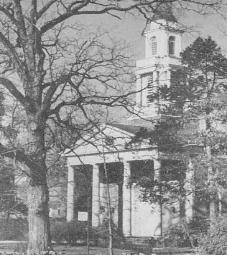
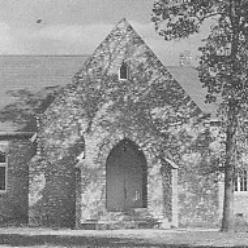
| Carrboro Baptist Sunday School abt. 1917; org. 1902 |
| Above: Walnut Grove Methodist Church, org. 1850 |
| Above: St. Mary's Episcopal Church, est. 1819 Below: Eno Presbyterian Church, org. 1755 |
| New Hope Presbyterian Church, Hillsboro, org. 1756 |
| Presbyterian Cemetery, Hillsboro |
| Little River Presbyterian Church, org. 1761 |
...